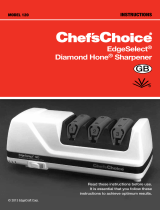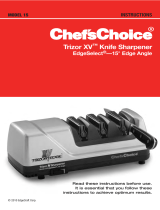Page is loading ...

CAUTION:
KNIVES ARE SHARP. HANDLE CAREFULLY.
DO NOT LEAVE WITHIN CHILDREN'S REACH.
Use & Care Instructions
Using Your Forged Cutlery
• Before using your cutlery for the rst time, hand-wash each knife with warm, soapy water, rinse and
dry thoroughly.
• Do not soak or leave food residue on the knives for long periods of time. Supercial pitting and/or
staining on the blades may occur if very salty or acidic foods are left on the knives.
• It is never a good idea to leave your knives in the sink. You may cut yourself reaching in and may also
damage the blades by jostling them against the sink bottom and other metal utensils.
• To maintain the cutting edge of your knives, sharpen with a sharpening steel as often as needed.
• You can use either wood or poly cutting boards with your knives. We do not recommend glass or
marble cutting surfaces, since they will damage the sharp edge quickly.
• Also, avoid using the knives as a can opener, screwdriver or chisel. Never pry or twist the blades.
Knives are cutting instruments and the blade may be damaged with improper use.
Cleaning and Caring For Your Cutlery
Cleaning
• Although the knives are water-resistant and dishwasher-safe, harsh dishwasher detergents may dull
the nish of the handles and stain the blades over time. Automatic dishwashing can also damage
the blades by knocking them against other utensils. Therefore, to preserve the beauty and cutting
performance of your knives, we recommend hand washing and thoroughly drying after each use.
Maintaining Your Edge
• The sharpest knives are the safest knives because they offer you the most control. A sharp knife cuts
easily with little resistance. Sharper knives also render more elegant results. They glide and chop but
never shred or bruise. A dull knife will require more force, which lessens your control over the blade.
• With repeated use, the cutting edge of the knife blade begins to curve out of alignment into tiny “S”
shapes, diminishing the blade’s awless function. By honing the knife edge, the sharpening steel
(included within your knife set) will help you straighten out these “S” shapes.
• Frequent sharpening is essential and will keep your knife cutting like new.
• When using your sharpening steel, gentle pressure is all that is needed. You do not want to grind
your knife. Speed is not important. It is most important to maintain the angle and to sharpen the full
length of the cutting edge.
FORGED TRADITIONAL
STAIN-FREE, HIGH-CARBON GERMAN STEEL
GOURMET
Step 1:
Hold the sharpening steel vertically, point
down, resting securely on a wooden cutting
board or towel. Keep the blade at a 20-degree
angle when you hone. You should be able to
see the contact point between the knife and
the steel.
Step 2:
Start with the heel of the knife blade at the top
of the steel. Pull the blade from bolster to tip,
while moving down the steel. Switch sides and
pull bolster to tip again. Repeat this technique
4-5 times on each side.

©COPYRIGHT 2017, TRAMONTINA USA, Inc. TRAMONTINA® is Reg. U.S. Pat. & TM. Off.
Packaging Designed by TDS.
Lifetime Warranty
This product is warranted by TRAMONTINA to be free from defects in material and
workmanshi
p for the lifetime of the original purchaser. Any piece will be repaired or
replaced at no charge with the same item or one of equal or better value if it is found to
be defective under normal, noncommercial household use and when cared for according
to the manufacturer’s instructions. This warranty does not cover lost or stolen items or
defects caused by accidents, re, or abuse or misuse of the products, including but not
limited to overheating, improper cleaning with harsh cleansers or detergents, neglect,
alteration, or use in commercial establishments.
For repair or replacement, return defective merchandise by package delivery service or
insured parcel post with a letter of explanation to the customer service department listed below.
This warranty gives you specific legal rights, and you may also have other rights, which
vary according to country, state or province.
Any questions regarding this warranty and/or the use and care of this product should be
directed to:
TRAMONTINA USA, Inc.
Customer Service
12955 West Airport Blvd.
Sugar Land, TX 77478-6119
(800) 221-7809
www.tramontina-usa.com
STYLE
MADE IN BRAZIL
Packaged in USA
IMPORTANT
• ALWAYS CUT AWAY FROM YOUR BODY.
• NEVER TRY TO CATCH A FALLING KNIFE.
• AFTER HANDLING A KNIFE, ALWAYS SET IT DOWN SAFELY WITH THE BLADE
FACING AWAY FROM YOU.
• NEVER USE YOUR KNIVES TO OPEN BOXES, OR OTHERWISE STAB, PULL
OR LIFT MATERIALS OTHER THAN FOOD.
• AVOID STORING KNIVES LOOSE IN A DRAWER. THE INCLUDED COUNTER BLOCK IS IDEAL
FOR ORGANIZING AND SAFELY STORING YOUR KNIVES.
(BR.80008-TBD - 062917)
/


